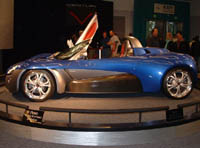Future electric car will need 7,000 cell phone batteries to run
Several notable efforts are taking place to bring all-electric or plug-in hybrid-electric vehicles to market.

Here's a snapshot of what's going on on the market of electric vehicles.
At least two car makers are viewing electric cars as a high-end niche market - something the Hollywood or well-heeled Silicon Valley set will want to embrace simply for the cool factor.
Tesla Motors, a Silicon Valley start-up, has been keeping its sports car under tight wraps for months, showing it only to a privileged few.
Tesla's first vehicle, an electric sports car set to be unveiled later this month, runs on the same lithium-ion batteries found in cameras and cell phones - 7,000 of them per vehicle, the inventors told me. They claim that the Tesla Roadster, built on the chassis of a Lotus Elise, will go from 0 to 60 mph in just four seconds, travel 250 miles before needing to be recharged (by plugging in to a regular AC outlet), and retail for about $80,000. They intend that Tesla's second-generation car, due out in 18-24 months, will be somewhat more popularly priced at around $50,000.
The Tesla rolls in the same league as the Wrightspeed, another Silicon Valley entrant. (Founder Ian Wright formerly worked at Tesla.) Wrightspeed's X1 model is a high-performance all-electric $120,000 roadster that beat out a $440,000 Porsche on a test track.
The X1, which is not yet in production, boasts a quarter ton of rechargeable batteries.
Clearly, neither Wrightspeed nor Tesla are looking to sell to the hoi polloi, though each company claims to be making technological advances in electric vehicles that will eventually filter down to more mass-market models - probably manufactured by others.
There's also the Tango, a novel EV offered by Seattle-based Commuter Cars Corp. The Tango seats two people - one behind the other, like on a motorcycle - and the super-slim, battery-driven vehicle that results is designed to slip in and out of traffic and parking spaces in ways conventional cars can't. Tango's most affordable model is priced at $18,700, but don't hold your breath: According to the company's Web site: "This car has not been designed yet as it will require a team of engineers, tens of millions of dollars, and at least 18 months to meet all of the safety requirements."
And then there's the Th!nk. This nifty little EV, developed by a Norwegian design team, was sold as the CityBee in Europe and the Citi in the U.S. , before being purchased by Ford in 1999. Ford leased just over 1,000 of them throughout Europe and the U.S. , comprising the world's largest EV fleet. But in 2004, much to the chagrin of environmentalists and others,Ford sold Th!nk to a European firm, which went bankrupt early this year. The company's remnants were purchased in March by a group of Norwegian investors that is looking to introduce the vehicle back into the U.S. market, makower.typepad.com reports.
Even before such vehicles hit the roads, a new generation of plug-in hybrid-electric vehicles is likely to take EVs out of the realm of hobbyists and techies and into the mainstream. As CalCars, a California nonprofit that's been rabidly promoting PHEVs of late, explains:
Plug-in hybrids (PHEVs) are like regular hybrids but with larger batteries and the ability to re-charge from a standard outlet (mostly at night). They're the best of both worlds: local travel is electric, yet the vehicle has unlimited gasoline range.
CalCars is among several groups that have modified Toyota Priuses and other hybrids to run on electricity-only while traveling in town, resulting in overall fuel economy exceeding 100 miles per gallon of gas in most cases.
PHEVs offer an additional benefit that could help greatly boost their appeal: Their ability to store electricity to be used when needed - whether on the road (to power computers or other appliances) or at home (as an emergency generator during power outages). Explains HybridCars.com:
Someday, the larger battery packs used in plug-in hybrids could juggle power back and forth from the car to your household current. If adopted on a widespread basis, a fleet of plug-in (a.k.a. "gridable") hybrids could offer what are called "regulatory services" (keeping voltages steady, etc.) to a modernized electric power grid. It is estimated that what's called "V2G" could benefit individual car owners by as much as $2,000 to $3,000 per year for the use of their energy storage capacity - offsetting their purchase and operating costs.
In one of its recent articles Pravda.ru wrote about the advantages of electric vehicles (EV). Among them are the following.
1. EVs produce zero emissions at the point of use.
2. An electric motor is 400% to 600% more efficient than an internal combus tion engine .
3. An EV, per mile, uses one-half the fossil-fuel resources an ICE consumes.
4. An EV produces only 5% to 10% of the emissions of an ICE per mile traveled.
5. EVs can use electricity from anywhere including sustainable energy resources (wind and sun).
6. EVs are simple, silent, and affordable to operate.
Source: agencies
Prepared by Alexander Timoshik
Pravda.ru
Discuss this article on Pravda.ru English Forum
Subscribe to Pravda.Ru Telegram channel, Facebook, RSS!





